The subtleties of growing
Ideal for growing damask roses in the south of Russia, but gardeners of the Middle Belt, Siberia and the Far East region also successfully use them on their personal plots and in the design of city parks as a decorative type. Of course, industrial cultivation of the variety to obtain essential oil in most regions of Russia is impossible. When planting in territories north of the Voronezh region, rose bushes must be provided with a covering material for the winter.
The place for the rose on the site must be chosen carefully: protect the bush from the scorching sun, but also do not plant it in a corner that is constantly in the shade. The shade provokes the appearance of powdery mildew and various fungal infections, and flowering can become very scarce. It is advisable to protect the bushes from drafts. Planting is usually carried out in the spring on a flat area in fertile soil warmed by the sun: black soil or loose loam.

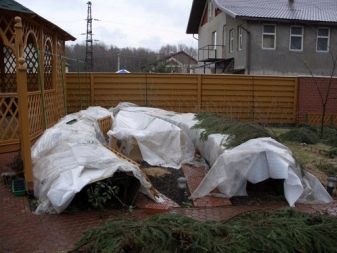
If you plan to plant several plants, the distance between the bushes should be at least 70-80 cm. A layer of nutrient mixture is poured into the prepared depression (about 50x50 cm): humus, humus, mineral fertilizers. All damaged, diseased and dry roots must be removed from the seedling. The root collars are buried by 5 cm, the planting hole is covered with soil and watered abundantly. Ideally, the soil around the seedling should be mulched using sawdust or peat. Mulch eliminates the need for frequent watering.
Watering the plant is regulated by the temperature regime: on hot days it should be increased up to 2 times a week, and gradually reduced as autumn approaches. Before the onset of frost, roses should be watered abundantly, up to 30 liters per bush.
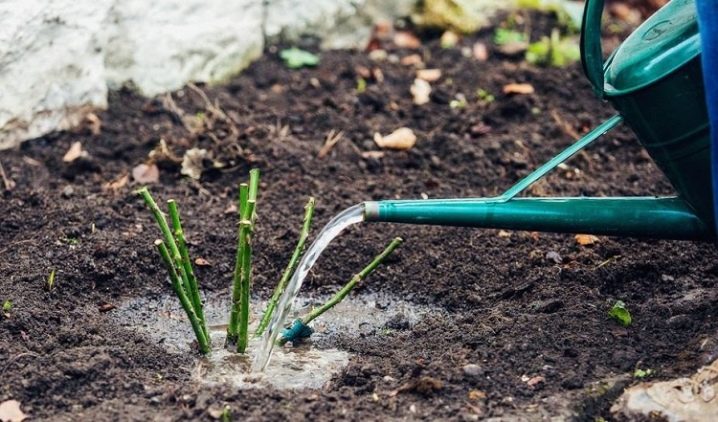
The rose bush requires crown formation. It can even be done in the first year and then sanitized pruning regularly in early spring.
When the roses have faded and the night temperatures drop, you need to cover their root system for the winter. Most often, peat is used for this or simply a layer of earth about 15 cm high is poured around the trunk. In the spring this shelter is removed when the probability of frost return has already disappeared.
Damascus rose is a wonderful old variety that does not require excessive maintenance, but with enough love, it will give your garden not only a bright flowering, but also a stunning aroma.
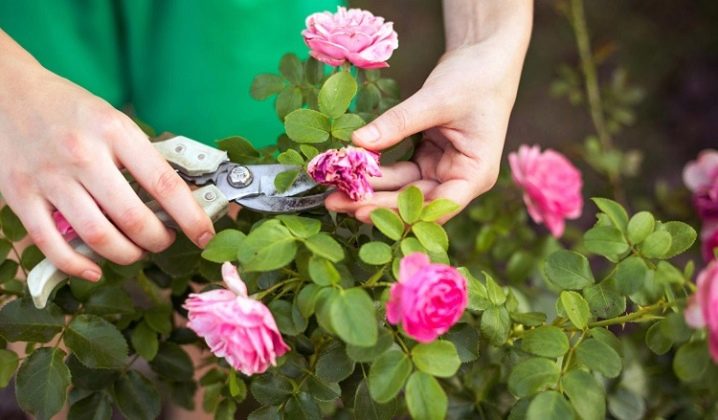
For the history of the origin of the Damascus rose, see the video below.
Care rules
For the first 15 days after planting, a young climbing rose should be protected from direct sunlight. Further care for her is not difficult, but it has certain features.
Watering
Despite the resistance of the described plant to a lack of moisture, one should not wait for the soil to completely dry out in the trunk circle. If there is no precipitation, during the first year after planting, the "Lagoon" should be watered relatively often - about once every 5 days, and after the specified period - twice less often. In the presence of rain, this procedure should be carried out in accordance with the degree of their intensity.
Fertilization
If organic fertilizing was introduced into the soil used for planting the plant, during the next year it should be fertilized only with mineral complexes. It is advisable to do this 4-5 times throughout the season, guided by the simplest algorithm:
- at the beginning of the growing season - nitrogen compounds;
- in the middle - a combination of potassium and phosphorus preparations;
- at the end - only potash dressings.
Garter
In order for the appearance of a rose bush to correspond to the preferences of its owner, the latter must adhere to the following recommendations:
- the horizontal orientation of the main shoots of the plant makes it look like a blooming cloud;
- if the choice is made in favor of a fan arrangement, the lateral branches should remain free;
- performing a garter of a rose to an arch, it is necessary to direct its stems in a spiral.
And also it should be borne in mind that "Laguna" belongs to the tall climbing varieties, and therefore it needs reliable support.
Pruning
The spring carrying out of the procedure in question involves the removal of shoots that could not survive the winter. The remaining stems are pruned high.
With the onset of autumn, it is necessary to remove dried flowers and shorten the stems by about 1/3 of the length, which is required to shelter them from the cold. But it is also worth getting rid of the stems that have reached 3 years of age - in order to avoid a decrease in the quality of flowering.
Preparing for winter
A drop in temperature below -7 ° C means that it is time to cover the "Laguna" rose for the winter. To do this, it is necessary to remove it from the support and place it on the ground, filling the resulting free space with branches of coniferous trees.
In conclusion, it remains to cover the plant with a material that allows air to pass through well, and place spruce branches, roofing felt and boards on top of it.
Diseases and pests
As mentioned earlier, illnesses rarely bother Laguna. As for the parasites, from the invasion of which roses of the described variety can suffer, these are:
- aphids that suck the juices from various parts of the plant and weaken them;
- spider mite, the activity of which leads to the degradation and death of leaves.
Pest control involves the use of broad-spectrum insecticides (for example, Actellika or Fufanona). Processing must be carried out twice, observing a 3-day interval.
In the next video you will see pruning of climbing roses of the varieties "Helen", "Laguna" and "Lavinia".
Let’s block ads! (Why?)
Landing
The process of planting a climbing rose should be approached with special care and thoroughness, because the process of its further development will depend on how correctly and efficiently you plant the plant. Gardeners note that the process of planting a rose "Flamenant" can be carried out 2 times a year: in the autumn or spring.
So, if you decide to plant a bush in the fall, then it is important to have time to do this while the air temperature is more or less warm (until early October). This must be taken into account without fail, otherwise the root system will not have time to take root before the onset of frost, and the harsh climatic conditions will simply destroy it.
In this regard, it is the spring planting that is considered the most favorable - if you choose this method, then in the summer you will be able to "reap the fruits" of your labors and admire the colorful bush growing in your front garden. However, even when planting in the spring, a number of points must be taken into account. First of all, you need to wait for the arrival of heat (you should not plant roses in early March). It is necessary to wait a certain period so that the ground in which you will plant the rose has time to warm up (the lowest possible temperature of the soil suitable for planting, experts consider the temperature to be + 10– + 12 degrees Celsius).
Having figured out the landing time, you need to move on to the process of choosing a specific place. So, the area that will be suitable for landing "Flamenants" should be intensely and continuously (during the day) illuminated by sunlight. If these conditions are met, then your rose in the process will release a large number of healthy and large flowers.
The second indicator to which you should pay close attention is the protection from the wind.
One of the most important factors when planting is undoubtedly soil quality.So, it is recommended to plant a shrub in sandy loam soil, which contains humus (if necessary, you can add it yourself). In such conditions, not only the flowers themselves, but also the stems of the rose will actively develop
In addition, it is important to pay attention to the amount of moisture (in particular - pay attention to the process of moisture accumulation during precipitation). If necessary, a system for draining excess liquid should be organized, otherwise the plant will not be able to develop properly and will die (the root system will simply rot)
It is worth considering the detailed instructions for the planting process.
- Even before starting the planting process, it is necessary to cut off the lashes and parts of the roots of the seedlings. It is recommended to leave cuttings, the size of which will not exceed 30 centimeters. In addition, it is necessary to process the sections: for the roots, ash is used for this purpose, and for the shoots, take a garden pitch.
- Now the treated seedlings should be placed in water for several hours. Having done this manipulation, you will significantly speed up the process of engraftment.
- Now it's time to start the actual landing. For this you need to prepare the ground. So, the area on which it is planned to plant a rose should be dug up without fail (the depth of the digging should be similar to the length of the shovel bayonet).
- When organizing holes for seedlings, it must be borne in mind that there should be at least 100 centimeters of free space between them. The recommended hole dimensions are 50 by 50 centimeters.
- The wells should be watered with water, and then, after the water is absorbed, a drainage coating should be made at their bottom (its thickness is at least 25 centimeters). Pebbles or crushed bricks can be used as drainage material.
- The next layer after drainage should be a mixture of clay substrate and manure (in a ratio of 2 to 1). It is also recommended to add several tablets of phosphorobacterin to the mixture.
- Now a stalk, processed and seasoned in water, should be placed in the hole, which must be sprinkled on top with soil and tamped.
The most beautiful varieties of climbing roses
It is difficult to single out the beautiful species of this family, since each grower has his own favorites. But the varieties below have been appreciated by rose lovers in many countries, which allows them to be ranked as hits.
Polka
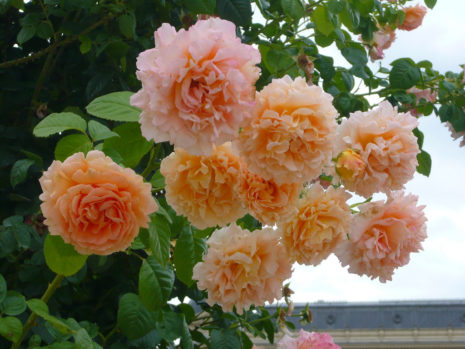
Climberg of French selection, with lush flowering. It is appreciated for the unusual color of the petals: pale pink with an apricot tint. Double flowers with wavy petals.
Cultivated as a climbing species, like a scrub (bush). Average winter hardiness, therefore, in the middle lane it needs light shelter.
Parade
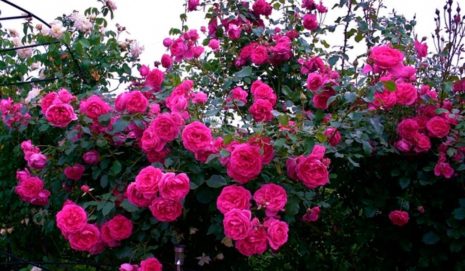
As befits a plant with such a solemn name, the Parade is distinguished by its special luxury. On powerful bushes with a large number of leaves, numerous large cherry-colored flowers are formed.
At the peak of flowering, the shoots are bent under the weight of the buds, so it is imperative to substitute supports. The variety is frost-resistant, but does not tolerate dampness.
Kimono

A modified form of the famous bush rose, characterized by long shoots and high resistance to cold. The flowers are large, with numerous rich pink petals.
Outwardly, Kimono resembles old roses, but unlike them, it has no scent. Up to 20 flowers are formed on the stem, the duration of flowering is up to three days (this is considered one of the "minuses" of claming).
Gloria Day
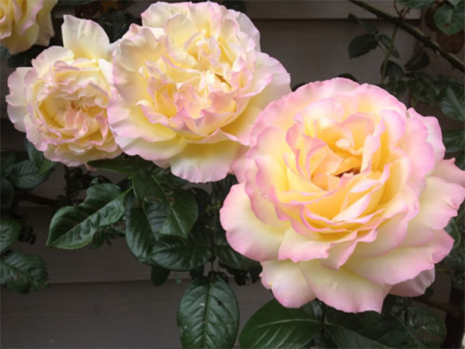
A version based on the hybrid tea rose of the same name, but not so famous and popular
Climing originated in the USA, when buying, you should pay attention to the marking (the climbing shape has the letters Cl)
The rose is valued for its originality of color: whitish-yellow with a pink border around the edges of the petals. It enters the flowering time late (early July), good lighting is required (the plant does not tolerate even a weak shade), it is unstable to cold weather. Cultivation in southern regions is recommended.
Madame Jules Gravero
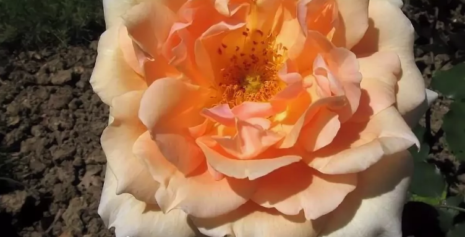
Luxurious rose, included in the subspecies of tea-grade climings. The plant is powerful, up to two meters tall, with shiny dark green leaves.
The flowers are large, with a weak fragrant aroma, delicate peach color. It blooms twice, requires proper care and sufficient lighting.
Variety history
China, India, the island of Crete and Ancient Iran (Persia) have long been arguing about the right to be called the homeland of the queen of flowers. It is no coincidence that Persian poets called their homeland Gulistan - the land of roses. Damascus rose (Rosa damascena) also traces its history from the luxurious gardens of the Middle East. In the valley of the Barada River, fertile land became the site of the founding of one of the richest and most famous cities of antiquity. Lying at the intersection of trade routes, the Ancient Damascus kingdom, called in poetry "fragrant Eden", was distinguished by a mild climate and an abundance of greenery; it was a real oasis in the middle of the desert.
The image of the damask rose can be seen in the surviving frescoes of ancient Pompeii, the flower was very popular in the Roman Empire. Then the variety underwent some oblivion in order to revive with renewed vigor in the Arab East. It is not for nothing that the Arabs are considered the pioneers of the method of obtaining rose water by distillation.
Thanks to roses, history has retained the name of the crusader Robert de Brie: fascinated by the fragrant damask shrub, he brought it to France in the middle of the 13th century. The variety quickly spread and dominated European gardening until the 19th century, when it was replaced by hybrids of Chinese tea roses.
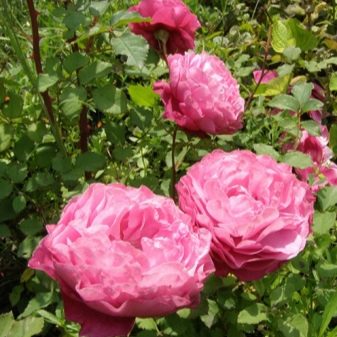
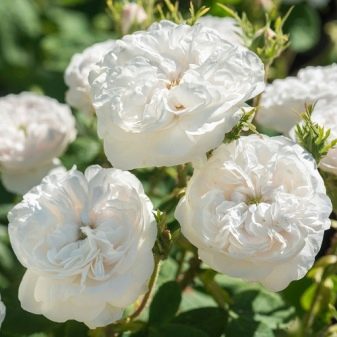
Description of the rose
The company "Wilhelm Cordes and Sons" has been breeding various varieties of roses for over 100 years. German breeders set themselves the goal of growing beautifully flowering, unpretentious plants. Thanks to their hard work, the world has the opportunity to enjoy the gorgeous bloom of the Lagoon rose, which is the most spectacular representative of climbers.
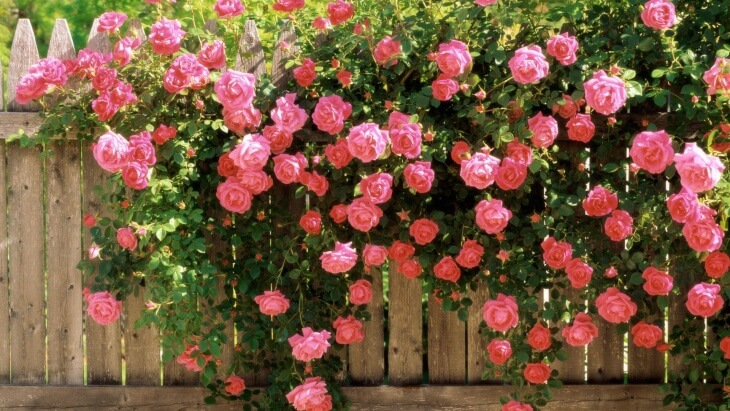
Laguna variety
Erect shoots, the height of which reaches 180-250 cm, are distinguished by abundant branching. Leaf plates with a shiny surface are painted in dark green tones. Red-crimson buds are naturally endowed with a large size. The upper part of the buds is pointed upwards.
The diameter of the flower calyx can exceed 9 cm. Flowers of the decorative culture are densely doubled. Each flower consists of 55-60 petals, which are collected in a brush of 7-8 pieces. The outline of the Lagoon rose is similar to the ancient plant varieties with thorns.
For reference! The aroma of flowers, combining fruit notes with rose hips, quickly spreads over the area and even goes beyond.
Varieties Blue and Sweet
Experts distinguish two varieties of the Laguna variety: Blue and Sweet. The distinctive characteristics of each subspecies are described below.
As it grows, the Blue Lagoon rose can surprise: its purple flowers gradually change their shade to light purple. The variety belonging to the climber category is medium in size. The stems of the ornamental culture are literally dotted with crooked thorns. On semi-double rose flowers, the number of petals does not exceed 40-45 pieces. Rose Blue Lagoon, as it is often called in Russian, is often used by landscape designers in the process of transforming a site.
In the Sweet variety, the flowers of the plants are painted in an amazingly delicate pink palette. In the aroma of the buds, you can feel a combination of notes of lemon and geranium. The large flowers of Laguna Sweet can be classified as terry.
Advantages and disadvantages
Rose Laguna has many benefits.
The variety is different:
- frost resistance;
- abundant flowering;
- unpretentiousness;
- rich aroma that spreads throughout the garden area;
- disease resistance;
- rapid growth;
- minimal tendency to fade.
Note! The variety of roses bred by German breeders has some disadvantages. The thorns are too close to each other, so cutting the plants is not so easy
It is also worth considering that the bushes need winter shelter.

Blue Lagoon
Landscape designers plant shrubs of an ornamental plant with thorns near the supports. Rose Lagoon is often used to create garden arches. The culture is effectively combined with other hybrid weaving and tea roses, the flowers of which are painted in raspberry, yellow and white shades.
Advantages and disadvantages
Among all the advantages of the climbing rose "Laguna", which make it consistently popular, a special place is occupied by the impressive duration of flowering. The winter hardiness of the plant in question is also worthy of mention: being properly covered, it painlessly withstands temperatures down to -28 ° C. Given this circumstance, the described variety can be successfully grown in the Moscow region and other regions with similar climatic conditions.
In addition to those already listed, the Laguna rose has the following obvious advantages:
- abundant flowering, due to which the foliage of the plant is practically invisible;
- unpretentiousness, allowing you to endure a moisture deficit and many other troubles;
- intense aroma spreading throughout the garden;
- resistance to the vast majority of diseases, including powdery mildew and black spot most characteristic of roses;
- rapid growth, which allows you to decorate the adjoining territory with the least amount of time;
- high resistance to rain;
- minimal tendency to fade, characteristic of the plant petals.
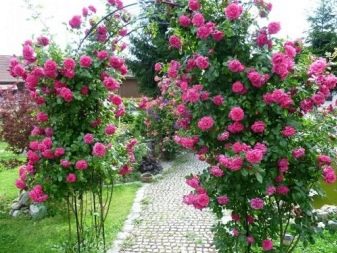
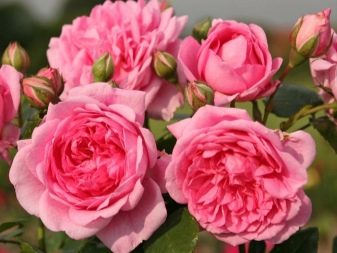
As for the shortcomings of the described climbing rose, the main one is a large number of strong and sharp thorns covering its stems. Other, less noticeable, disadvantages of the "Laguna" include the need to arrange a winter shelter and not the highest resistance to aphids and spider mites.
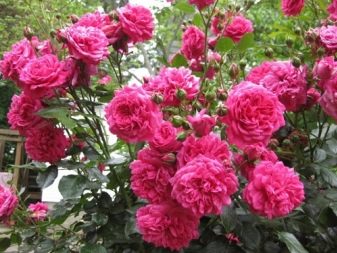
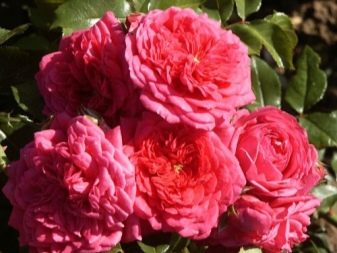
Care
Despite the fact that the rose "Don Juan" is unpretentious, it needs proper care
Paying due attention to the flower garden, the gardener will get a good harvest in the form of large numerous buds. Seasonal care includes the following activities
- Watering. Climbing shrubs need a lot of liquid. Before planting, pour at least 15 liters of water under the root of each shoot. Further, the soil is watered as it dries. During periods of drought, it is recommended to water the plants every other day, while the water consumption should be at least 15-20 liters for each rose bush.
- Top dressing. Don Juan grows rapidly and blooms profusely, which is why it needs vital nutrients. Experienced gardeners advise feeding the flower garden at least 6 times during the growing season. To do this, use ammonium nitrate, potassium salt, superphosphate, chicken droppings.
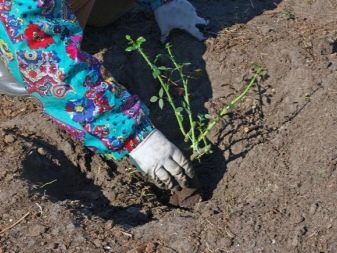
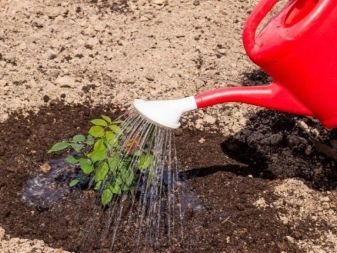
- Loosening. Abundant growth and flowering of the plant will be ensured by the penetration of oxygen to the roots. For this, it is necessary to prevent the formation of a hard earth crust. Loosening will help in this matter. It is recommended to make it after each watering of the bush. To make the task easier, some gardeners mulch the soil using rotted sawdust, wood chips or compost. This makes the soil softer, and it no longer needs constant loosening.
- Stealing. To stimulate flowering, as well as contribute to the formation of an elegant crown of the flower garden, shrubs should be cut once a year. Experts advise to shorten fresh shoots by 25-30% of their length. Unripe shoots need to be completely removed. When they are left, there are great risks of decay.
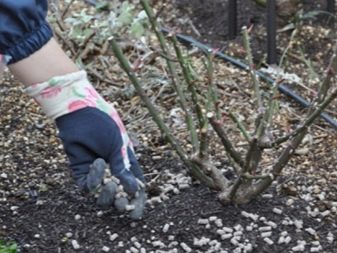
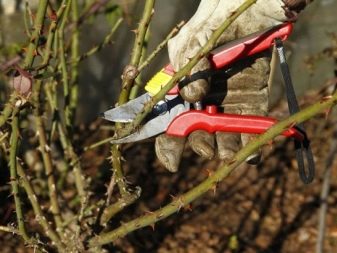
Rose "Don Juan" is frost-resistant, but this does not mean that the plant can withstand too low temperatures (below -20)
If a rose is bred in a harsh climate, it is important to ensure its insulation in winter. To do this, the shrub is freed from dried leaves and flowers, the lashes are neatly folded on spruce branches, and they also cover the plant from above
Next, any non-woven material is laid.
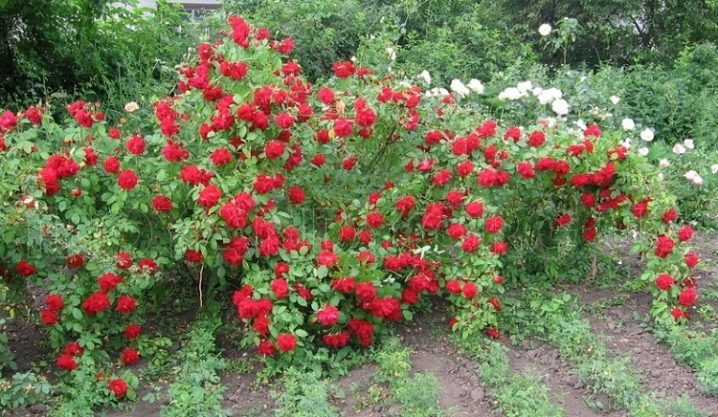
Exchange of experience of gardeners growing the rose "Maiden's Dreams"
- Katerina Evgenievna, (Shtormovoe village, Crimea, 6th zone).
- Lyudmila Sergeevna, (Yaroslavl region. 3 zone).
I purchased this variety "Maiden Dreams" in 2014 from GBS in Moscow. Since then, there is no more beautiful rose in my garden. In the first year, it grew to one meter. Hibernates under agrospan - 60. Never froze over. Last year's spring frosts withstood with honor, and even the very first bloomed. Over the past years, she has not been seen in diseases. In my garden, the brightest and most beautiful rose.
- Valeria Andreevna, (Zheleznogorsk, zone 5).
My rose is grown from a cuttings. And although they say that self-rooted roses are weaker, it grows well and blooms no worse than other grafted ones. It blooms for a long time, about a month. In our rainy climate, by the end of summer it is covered with black spot.
- Kira Borisovna, (Leningrad region, zone 4).
A beautiful rose, blooms beautifully, but tortured by black spot. Yes, it's also a shelter for the winter, I can't guess when it needs to be done. Two years ago in winter, the bush froze, probably because it covered it late. Last year, she wrapped him up in October and he smelled. But, it is true, in one and the other case, the shoots have grown well and bloomed, but the bush is not high, a little more than one meter. My rose behaves more like a bush rose than a climbing one.


